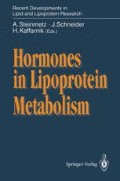Abstract
Steroid hormones bind to their corresponding receptors in the cytoplasm of responsive cells and this complex is translocated to the nucleus where the hormone-receptor-complex binds to specific DNA sequences located in the regulatory regions of the target gene. These specific DNA sequences are referred to as hormone responsive elements (HRE) and act as enhancer elements such that when the receptor complex binds, transcription is induced. In the absence of ligand the hormone receptor is maintained in an inactive form by association with other cellular proteins.
Access this chapter
Tax calculation will be finalised at checkout
Purchases are for personal use only
Preview
Unable to display preview. Download preview PDF.
References
Akerblom IE, Slater EP, Beato M, Baxter JD, Mellon PL (1988) Negative Regulation by Glucocorticoids Through Interference with a cAMP Responsive Enhancer. Science 241: 350–353.
Beato M (1989) Gene Regulation by Steroid Hormones. Cell 56: 335–344.
Bruggemeier U, Kalff M, Franke S, Scheidereit C, Beato M (1991) Ubiquitous Transcription Factor OTF-1 Mediates Induction of the MMTV Promoter through Synergistic Interaction with Hormone Receptors. Cell 64: 565–572.
Bruggemeier U, Rogge L, Winnacker EL, Beato M (1990) Nuclear factor I acts as a transcription factor on the MMTV promoter but competes with steroid hormone receptors for DNA binding. EMBO J 9: 2233–2239.
Chalepakis G, Arnemann J, Slater EP, Bruller H-J, Gross B, Beato M (1988)Differential gene activation by glucocorticoids and progestins through the hormone regulatory element of mouse mammary tumor virus. Cell 53: 371–382.
Cordingley MG, Riegel AT, Hager GL (1987) Steroid-dependent interaction of transcription factors with the inducible promoter of mouse mammary tumor virus in vivo. Cell 48: 261–270.
Hard T, Kellenbach E, Boelens R, Maler BA, Dahlman K, Freedman LP, Carl- sted-Duke J, Yamamoto KR, Gustafsson J, Kaptein R (1990) Solution structure of the glucocorticoid receptor DNA-binding domain. Science 199: 157–160.
Kalff M, Gross B, Beato M (1990) Progesterone receptor stimulates transcription of mouse mammary tumor virus in a cell-free system. Nature 344: 360–362.
Lucibello FC, Slater EP, Jooss KU, Beato M, Muller R (1990) Mutual transrepression of Fos and the glucocorticoid receptor: involvement of a functional domain in Fos which is absent in FosB. EMBO J 9: 2827–2834.
Oro AE, Hollenberg SM, Evans RM (1988) Transcriptional inhibition by a glucocorticoid receptor-J3-galactosidase fusion protein. Cell 55: 1109–1114.
Piña B, Bruggemeier U, Beato M (1990) Nucleosome positioning modulates accessibility of regulatory proteins of the mouse mammary tumor virus promoter. Cell 60: 719–725.
Slater EP, Redeuilh G, Thesis K, Suske G, Beato M (1990) The uteroglobin promoter contains a non-canonical estrogen responsive element. Mol Endocrinol 4: 604–610.
Truss M, Chalepakis G, Beato M (1990) Contacts between steroid hormone receptors and thymines in DNA: An interference method. Proc Natl Acad Sci USA 87: 7180–7184.
Truss M, Chalepakis G, Slater EP, Mader S, Beato M (1991) Functional Interac-tion of Hybrid Response Elements with Wild-Type and Mutant Steroid Hormone Receptors. Mol Cell Biol 11: 3247–3258.
Zaret KS, Yamamoto KR (1984) Reversible and Persistent Changes in Chromatin Structure Accompany Activation of a Glucocorticoid-dependent Enhancer Element. Cell 38: 29–38.
Editor information
Editors and Affiliations
Rights and permissions
Copyright information
© 1993 Springer-Verlag Berlin Heidelberg
About this paper
Cite this paper
Slater, E.P., Beato, M. (1993). Interaction of Steroid Hormone Receptors with DNA. In: Steinmetz, A., Schneider, J., Kaffarnik, H. (eds) Hormones in Lipoprotein Metabolism. Recent Developments in Lipid and Lipoprotein Research. Springer, Berlin, Heidelberg. https://doi.org/10.1007/978-3-642-84855-1_1
Download citation
DOI: https://doi.org/10.1007/978-3-642-84855-1_1
Publisher Name: Springer, Berlin, Heidelberg
Print ISBN: 978-3-540-55995-5
Online ISBN: 978-3-642-84855-1
eBook Packages: Springer Book Archive

